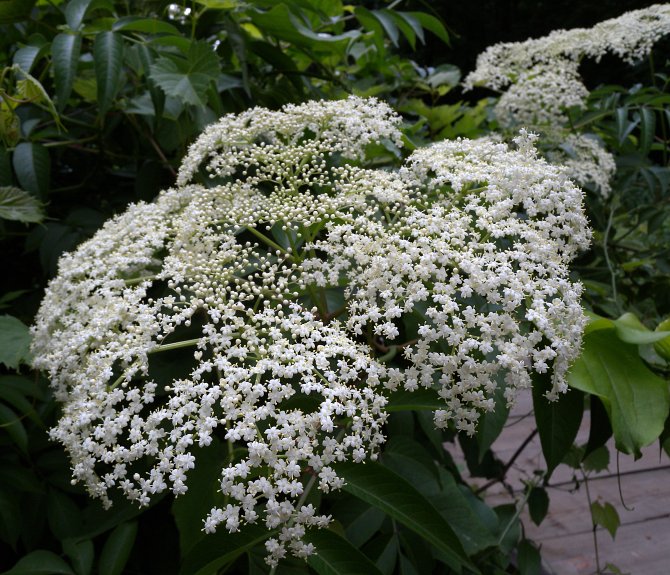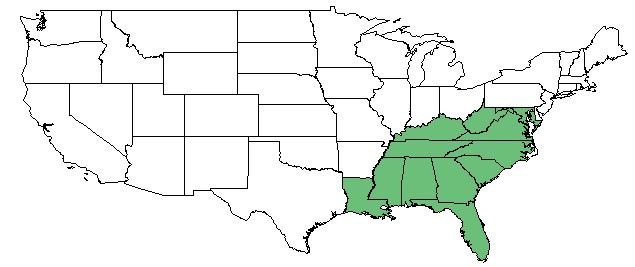Difference between revisions of "Sambucus canadensis"
(→Ecology) |
|||
| Line 42: | Line 42: | ||
===Fire ecology=== <!--Fire tolerance, fire dependence, adaptive fire responses--> | ===Fire ecology=== <!--Fire tolerance, fire dependence, adaptive fire responses--> | ||
''S. canadensis'' is not fire resistant, but has a medium fire tolerance.<ref name= "USDA Plant Database"/> | ''S. canadensis'' is not fire resistant, but has a medium fire tolerance.<ref name= "USDA Plant Database"/> | ||
| − | |||
| − | === | + | ===Pollination and use by animals=== <!--Herbivory, granivory, insect hosting, etc.--> |
''Sambucus canadensis'' has been observed to host bee species such as ''Andrena platyparia'' (family Andrenidae), ''Aphis sp.'' (family Aphididae), leafhoppers such as''Scaphytopius sp.'' (family Cicadellidae), bees such as ''Hylaeus leptocephalus'' (family Colletidae), ''Lasioglossum cinctipes'' (family Halictidae) and ''Stelis lateralis'' (family Megachilidae), and plant bugs from the Miridae family such as ''Lygus lineolaris, Oligotylus meridionalis, Oligotylus carneatus'' and ''Plagiognathus cornicola''.<ref>Discoverlife.org [https://www.discoverlife.org/20/q?search=Bidens+albaDiscoverlife.org|Discoverlife.org]</ref> ''S. canadensis'' is palatable to browsing animals.<ref name= "USDA Plant Database"/> | ''Sambucus canadensis'' has been observed to host bee species such as ''Andrena platyparia'' (family Andrenidae), ''Aphis sp.'' (family Aphididae), leafhoppers such as''Scaphytopius sp.'' (family Cicadellidae), bees such as ''Hylaeus leptocephalus'' (family Colletidae), ''Lasioglossum cinctipes'' (family Halictidae) and ''Stelis lateralis'' (family Megachilidae), and plant bugs from the Miridae family such as ''Lygus lineolaris, Oligotylus meridionalis, Oligotylus carneatus'' and ''Plagiognathus cornicola''.<ref>Discoverlife.org [https://www.discoverlife.org/20/q?search=Bidens+albaDiscoverlife.org|Discoverlife.org]</ref> ''S. canadensis'' is palatable to browsing animals.<ref name= "USDA Plant Database"/> | ||
<!--==Diseases and parasites==--> | <!--==Diseases and parasites==--> | ||
Revision as of 17:59, 18 June 2021
Common name: common elderberry[1], American black elderberry[2]
| Sambucus canadensis | |
|---|---|

| |
| Photo by John Hilty hosted at IllinoisWildflowers.info | |
| Scientific classification | |
| Kingdom: | Plantae |
| Division: | Magnoliophyta - Flowering plants |
| Class: | Magnoliopsida - Dicots |
| Order: | Dipsacales |
| Family: | Caprifoliaceae |
| Genus: | Sambucus |
| Species: | S. canadensis |
| Binomial name | |
| Sambucus canadensis (L.) R. Boll | |

| |
| Natural range of Sambucus canadensis from USDA NRCS Plants Database. | |
Contents
Taxonomic Notes
Subspecies: S. nigra Linnaeus ssp. canadensis (Linnaeus) R. Bolli
Varieties: S. canadensis var. submollis Rehder; S. simpsonii Rehder ex Sargent; Sambucus canadensis Linnaeus var. laciniata A. Gray
Description
S. canadensis is a perennial shrub/tree of the Caprifoliaceae family native to North America, Canada, and Puerto Rico and introduced to Hawaii, the U.S. Virgin Islands, and the Pacific Basin.[2]
Distribution
S. canadensis is found: everywhere in the United States excluding Washington, Oregon, Idaho, Nevada, and Utah; the Manitoba, Ontario, Quebec, New Brunswick, and Nova Scotia areas of Canada; every island of Hawaii; Puerto Rico; the Pacific Basin; and the U.S. Virgin Islands.[2] Specimens have been collected from swamp regions, bottomland woods, floodplain woods, and edge of fully shaded woods.[3]
Ecology
Habitat
S. canadensis has been found in streambanks, thickets, marshes, moist forests, swamps, bottomland woods, and open woodland floodplains.[4][1] It is also found in disturbed areas like along roadsides, fences, and pastures.[4] Associated species: Schismus, Xanthocephalum gymnospermoides, Juncus blaticus, Sambucus canadensis, Matelea producta, Physalis longifolia, Convolvulus arvensis, Anemopsis californica, Populus fremontii, Prosopis juliflora, Eleocharis palustris, Salix gooddingii, and Oligomeris.[5] S. canadensis proliferates in streambanks, thickets, marshes, moist forests, and disturbed areas.[1]
Phenology
S. canadensis has been observed to flower January through August.[6] The leaflets, particularly of young shoots or stunted sprouts, are often variegated. This is one of the first woody plants to leaf out in the spring. The variation is clinal, and bipinnate leaves are seen as far north as coastal NC.[1]
Fire ecology
S. canadensis is not fire resistant, but has a medium fire tolerance.[2]
Pollination and use by animals
Sambucus canadensis has been observed to host bee species such as Andrena platyparia (family Andrenidae), Aphis sp. (family Aphididae), leafhoppers such asScaphytopius sp. (family Cicadellidae), bees such as Hylaeus leptocephalus (family Colletidae), Lasioglossum cinctipes (family Halictidae) and Stelis lateralis (family Megachilidae), and plant bugs from the Miridae family such as Lygus lineolaris, Oligotylus meridionalis, Oligotylus carneatus and Plagiognathus cornicola.[7] S. canadensis is palatable to browsing animals.[2]
Conservation, cultivation, and restoration
Cultural use
Historically, the bark could be boiled down in lard to make a lotion for skin irritation, burns, and dryness. Other parts of the plant were also used in poultices to treat burns, sores, rheumatism, headache, and to make tonic wine and lotions for treating fevers.[8]
The berries can be used to make wine, pie filling, preserves, baking, and drinks. The flowers can be fried into fritters, and some think the greens can be prepared if harvested young.[9]
Photo Gallery
References and notes
- ↑ 1.0 1.1 1.2 1.3 Weakley, A. S. (2015). Flora of the Southern and Mid-Atlantic States. Chapel Hill, NC, University of North Carolina Herbarium.
- ↑ 2.0 2.1 2.2 2.3 2.4 USDA Plant Database https://plants.usda.gov/core/profile?symbol=SANIC4#
- ↑ URL: http://herbarium.bio.fsu.edu. Last accessed: June 2018. Collectors: Lisa Keppner, Ed Keppner, R.K. Godfrey, Grady W. Reinert, Wayne D. Longbottom, David H. Williams. States and counties: Florida (Bay, Marion, Union, Jefferson, Jackson, Leon, Seminole)
- ↑ 4.0 4.1 Florida State University Herbarium Database. URL: http://herbarium.bio.fsu.edu. Last accessed: June 2021. Collectors: Ed Keppner, Lisa Keppner, Wayne D. Longbottom, and David H. Williams. States and counties: Florida: Bay and Seminole.
- ↑ Arizona State University Vascular Plant Herbarium accessed using Southeastern Regional Network of Expertise and Collections (SERNEC) data portal. URL: http://sernecportal.org/portal/collections/index.php Last accessed: June 2021. Collectors: Walter Fertig and Jean-Philippe Solves. States and Counties: Arizona: Maricopa and Pima.
- ↑ Nelson, G. PanFlora: Plant data for the eastern United States with emphasis on the Southeastern Coastal Plains, Florida, and the Florida Panhandle. www.gilnelson.com/PanFlora/ Accessed: 29 MAY 2018
- ↑ Discoverlife.org [1]
- ↑ Korchmal, Arnold & Connie. 1973. A Guide to the Medicinal Plants of the United States. The New York Times Book Company, New York.
- ↑ Fernald, et al. 1958. Edible Plants of Eastern North America. Harper and Row Publishers, New York.